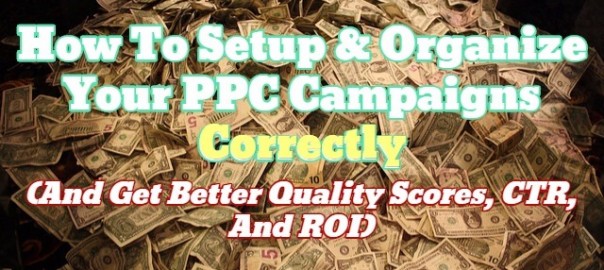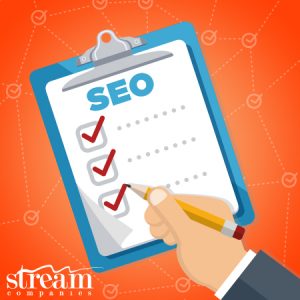
Co-authored with Kristen Godel.
The easiest way to get the best quality scores, click through rates, and highest return of investment from your pay per click campaign is to optimize the setup of your account from the start.
Account Structure

A well-structured account makes it easy to analyze metrics and determine which keywords are working.
You can easily attribute trending and results to a particular ad group when you have highly relevant, specific bundles of keywords throughout your account.
An account has campaigns.
Campaigns are composed of ad groups. Create a new campaign whenever a group has a different theme, targeting, or needs a separate budget.
Each ad group has ads with ad copy and the keywords they target.
Ads link to an actionable landing page relevant to the ad copy and its keyword.
Goals
To run a successful pay-per-click campaign you need to understand its goals.
Are you looking to improve your branding? Are you looking to drive more leads and sales?
A clear goal determines the networks you target, the keywords, ad copy, and many other aspects of your campaign. A campaign built around branding has a very different approach compared to one focused on sales.
Goal Determined Keywords
The PPC campaign goal determines your keyword strategy.
Let’s look at an example.
A Top Of Funnel campaign consists of keywords that are broad in nature. These keywords provide information to people in the early stages of the buying cycle. They typically don’t lead to direct sales but they guide the customer along the funnel by providing useful resources.
A travel client that sells adventure travel vacations to destinations worldwide has campaigns for each stage of the buying cycle. The keyword strategy for a Top Of Funnel campaign would focus on types of vacations with no specific location modifiers: hiking trips, cycling vacations, singles resort, etc.
Conversion goals for this type of campaign: download a piece of content, ask for a brochure, signup for newsletter, etc. The purpose is to inform and provide a starting point for a potential trip.
The goal of a campaign also determines the Call To Action (CTA) in your ad copy.
In our example ad copy would promote ‘download a brochure‘ as opposed to something more direct like ‘book now‘.
Middle Of Funnel campaigns would focus on the activities plus specific locations (continent or country). They are aimed at individuals who have done their research and must decide on where they want to travel. The keyword strategy in turn is more specific, with ad copy messaging focusing on available countries.
The most highly targeted strategy is the Bottom Of Funnel campaign with keywords geared towards specific vacations in a particular region. For example, ‘Inca trail hiking in Peru‘. The keyword strategy is specific and typically long-tail in nature. The ad copy promotes either ‘trip bookings‘ or specific details about the trip. In our example, our Call To Action could be ‘download trip notes‘ which provides an overview of the trip itinerary and detailed information such as duration, accommodation, price etc.
Keyword Research
Use Google AdWords Keyword Planner to find keywords. Start with the core keywords and searches most relevant for your business, and branch out from there.
Don’t rely solely on the keyword planner. Be intuitive and investigate keywords you think make sense for your business. Conduct various searches on Google to measure the competition for your core keywords.
Optimized Budget Use
Generally there is no “minimum budget” for most ad platforms. You are only limited by your own budget.
To determine your daily budget, divide your monthly spend by the number of days in the month. If you want to spend $750 in a month, your campaign’s daily budget is $25/day.
If you find you’re running out of budget too early, focus on a smaller set of core keywords (perhaps in a smaller geo region) or increase your daily budget.
Take average Cost Per Click into account and set a daily budget that allows for competitive bidding.
Low Budget
Sometimes your campaign won’t run properly if the budget is set too low. With a low budget there simply is not enough money per day to support the clicks coming in on your campaigns; your ads may not show.
If you budget is limited, focus only on the campaigns most relevant to your business. Look at budget preserving features such as Dayparting or Ad Scheduling
Dayparting
Take advantage of ad scheduling if you know there is no value to running your ads during specific time periods.
For example, if your primary goal is to get the customer on the phone to discuss details, don’t run ads at times when no one is available to answer the call.
Most businesses don’t know for sure what time of day is most valuable. Simply run a campaign within a reasonable time frame and access the results once enough data has been accumulated.
Ad Delivery
AdWords‘ standard ad delivery setting shows your ads evenly throughout the day. It may sound ideal but your ads don’t show for every search.
In my view, this leaves the performance of your campaign up to chance; a more qualified prospect might search your keywords while your ad isn’t eligible show due to the setting.
Although you may run out of budget early in the day on Accelerated Delivery, at least your ad shows every time your keywords is searched (within your budget constraints)
Relevance
To improve your campaign’s performance and spent your budget well you should keep you campaign relevant. Don’t add too many keyword.
If you consider a smaller budget for your campaign target services closest to your business goals.
If your budget increases and allows for it you can target searches that broaden your reach, even though it may be slightly less targeted.
Budget Cannibalization
Budgets cannot be set at the ad group level so it’s important to segment categories into specific campaigns to allow for maximum exposure.
For example, don’t group all locations into one campaign if a certain region generates much more traffic than the others. What happens is that one location eats up all the budget before the other locations have a chance to even generate an impression.
Same goes for certain ad groups (topics) that generate much more traffic than others. Create a single campaign for the most popular topic and leave the rest as multiple ad groups in another campaign.
Monitor & Optimize
Monitor the activity on your account. There may be optimizations to do post-launch to improve click-through rates and conversions. For example, you may need to add more relevant keywords, add negative keywords, revise call to actions, or even brush up your landing page to improve the overall campaign performance.
Sort your keywords by cost (highest to lowest) and assess whether or not the keywords spending the most money are providing enough value. Pause any keywords that have high costs but low returns, but make sure to attribute phone calls to the overall lead numbers (if applicable)
Often times keywords with high spends aren’t registering conversions (form submissions etc) in AdWords, but in many cases they are driving the most phone calls. Consider keyword level call tracking for the most accurate assessment of keyword value and performance.
Now Read:
- Currently Running AdWords? Here’s Why You Should Also Be Using Bing Ads
- Fix These 4 Campaign Elements To See Profits Soar And Costs Plummet
* Leader image adapted from aresauburn
How To Setup Your PPC Campaigns For Better Quality Scores, CTR, And ROI
The post How To Setup Your PPC Campaigns For Better Quality Scores, CTR, And ROI appeared first on Search Engine People Blog.
(249)





